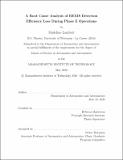| dc.contributor.advisor | Rebecca Masterson. | en_US |
| dc.contributor.author | Lambert, Madeline(Madeline Marie) | en_US |
| dc.contributor.other | Massachusetts Institute of Technology. Department of Aeronautics and Astronautics. | en_US |
| dc.date.accessioned | 2020-09-03T17:45:46Z | |
| dc.date.available | 2020-09-03T17:45:46Z | |
| dc.date.copyright | 2020 | en_US |
| dc.date.issued | 2020 | en_US |
| dc.identifier.uri | https://hdl.handle.net/1721.1/127077 | |
| dc.description | Thesis: S.M., Massachusetts Institute of Technology, Department of Aeronautics and Astronautics, May, 2020 | en_US |
| dc.description | Cataloged from the official PDF of thesis. | en_US |
| dc.description | Includes bibliographical references (pages 203-205). | en_US |
| dc.description.abstract | The Regolith X-ray Imaging Spectrometer (REXIS) is a student-built instrument flown on NASA's Origins, Spectral Interpretation, Resource Identification, Safety, Regolith Explorer (OSIRIS-REx) mission. During main science operations, the instrument experienced detector efficiency loss in the form of loss of iron calibration source counts, which greatly affected the science output. In this thesis, a root cause investigation is performed on the loss of iron counts, and an optical light leak onto the edge of the instrument's detectors is identified as the most likely cause. A CAST analysis is then performed to identify possible organizational and cultural causes of the design that allowed for an optical light leak, and recommendations for future similar instruments (low-cost, high-risk) are made. | en_US |
| dc.description.statementofresponsibility | by Madeline Lambert. | en_US |
| dc.format.extent | 205 pages | en_US |
| dc.language.iso | eng | en_US |
| dc.publisher | Massachusetts Institute of Technology | en_US |
| dc.rights | MIT theses may be protected by copyright. Please reuse MIT thesis content according to the MIT Libraries Permissions Policy, which is available through the URL provided. | en_US |
| dc.rights.uri | http://dspace.mit.edu/handle/1721.1/7582 | en_US |
| dc.subject | Aeronautics and Astronautics. | en_US |
| dc.title | A root cause analysis of REXIS detection efficiency loss during phase E operations | en_US |
| dc.type | Thesis | en_US |
| dc.description.degree | S.M. | en_US |
| dc.contributor.department | Massachusetts Institute of Technology. Department of Aeronautics and Astronautics | en_US |
| dc.identifier.oclc | 1191820963 | en_US |
| dc.description.collection | S.M. Massachusetts Institute of Technology, Department of Aeronautics and Astronautics | en_US |
| dspace.imported | 2020-09-03T17:45:46Z | en_US |
| mit.thesis.degree | Master | en_US |
| mit.thesis.department | Aero | en_US |
